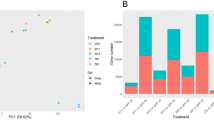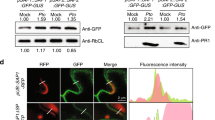Abstract
Many bacterial pathogens of plants and animals use a type III secretion system to deliver diverse virulence-associated ‘effector’ proteins into the host cell1. The mechanisms by which these effectors act are mostly unknown; however, they often promote disease by suppressing host immunity2. One type III effector, AvrPtoB, expressed by the plant pathogen Pseudomonas syringae pv. tomato, has a carboxy-terminal domain that is an E3 ubiquitin ligase3. Deletion of this domain allows an amino-terminal region of AvrPtoB (AvrPtoB1–387) to be detected by certain tomato varieties leading to immunity-associated programmed cell death4. Here we show that a host kinase, Fen, physically interacts with AvrPtoB1–387 and is responsible for activating the plant immune response. The AvrPtoB E3 ligase specifically ubiquitinates Fen and promotes its degradation in a proteasome-dependent manner. This degradation leads to disease susceptibility in Fen-expressing tomato lines. Various wild species of tomato were found to exhibit immunity in response to AvrPtoB1–387 and not to full-length AvrPtoB. Thus, by acquiring an E3 ligase domain, AvrPtoB has thwarted a highly conserved host resistance mechanism.
This is a preview of subscription content, access via your institution
Access options
Subscribe to this journal
Receive 51 print issues and online access
$199.00 per year
only $3.90 per issue
Buy this article
- Purchase on Springer Link
- Instant access to full article PDF
Prices may be subject to local taxes which are calculated during checkout




Similar content being viewed by others
References
Mudgett, M. B. New insights to the function of phytopathogenic bacterial type III effectors in plants. Annu. Rev. Plant Biol. 56, 509–531 (2005)
Abramovitch, R. B., Anderson, J. C. & Martin, G. B. Bacterial elicitation and evasion of plant innate immunity. Nature Rev. Mol. Cell Biol. 7, 601–611 (2006)
Janjusevic, R., Abramovitch, R. B., Martin, G. B. & Stebbins, C. E. A bacterial inhibitor of host programmed cell death defenses is an E3 ubiquitin ligase. Science 311, 222–226 (2006)
Abramovitch, R. B., Kim, Y.-J., Chen, S., Dickman, M. B. & Martin, G. B. Pseudomonas type III effector AvrPtoB induces plant disease susceptibility by inhibition of host programmed cell death. EMBO J. 22, 60–69 (2003)
Buell, C. R. et al. The complete genome sequence of the Arabidopsis and tomato pathogen Pseudomonas syringae pv. tomato DC3000. Proc. Natl Acad. Sci. USA 100, 10181–10186 (2003)
Pedley, K. F. & Martin, G. B. Molecular basis of Pto-mediated resistance to bacterial speck disease. Annu. Rev. Phytopathol. 41, 215–243 (2003)
Martin, G. B. et al. Map-based cloning of a protein kinase gene conferring disease resistance in tomato. Science 262, 1432–1436 (1993)
Mucyn, T. S. et al. The tomato NBARC-LRR protein Prf interacts with Pto kinase in vivo to regulate specific plant immunity. Plant Cell 18, 2792–2806 (2006)
Martin, G. B. et al. A member of the Pto gene family confers sensitivity to fenthion resulting in rapid cell death. Plant Cell 6, 1543–1552 (1994)
Kim, Y.-J., Lin, N.-C. & Martin, G. B. Two distinct Pseudomonas effector proteins interact with the Pto kinase and activate plant immunity. Cell 109, 589–598 (2002)
Abramovitch, R. B., Janjusevic, R., Stebbins, C. E. & Martin, G. B. Type III effector AvrPtoB requires intrinsic E3 ubiquitin ligase activity to suppress plant cell death and immunity. Proc. Natl Acad. Sci. USA 103, 2851–2856 (2006)
Chang, J. H. et al. Functional analysis of the Pto resistance gene family in tomato and the identification of a minor resistance determinant in a susceptible haplotype. Mol. Plant Microbe Interact. 15, 281–291 (2002)
Pascuzzi, P. E. Structure-based functional analyses of Pseudomonas type III effector protein AvrPto and evaluation of putative virulence targets in tomato. PhD thesis, Cornell Univ. (2006)
del Pozo, O., Pedley, K. F. & Martin, G. B. MAPKKKα is a positive regulator of cell death associated with both plant immunity and disease. EMBO J. 23, 3072–3082 (2004)
Jia, Y., Loh, Y.-T., Zhou, J. & Martin, G. B. Alleles of Pto and Fen occur in bacterial speck-susceptible and fenthion-insensitive tomato and encode active protein kinases. Plant Cell 9, 61–73 (1997)
Riely, B. K. & Martin, G. B. Ancient origin of pathogen recognition specificity conferred by the tomato disease resistance gene Pto. Proc. Natl Acad. Sci. USA 98, 2059–2064 (2001)
He, P. et al. Specific bacterial suppressors of MAMP signaling upstream of MAPKKK in Arabidopsis innate immunity. Cell 125, 563–575 (2006)
de Torres, M. et al. Pseudomonas syringae effector AvrPtoB suppresses basal defence in Arabidopsis. Plant J. 47, 368–382 (2006)
Badel, J. L., Shimizu, R., Oh, H. S. & Collmer, A. A Pseudomonas syringae pv. tomato avrE1/hopM1 mutant is severely reduced in growth and lesion formation in tomato. Mol. Plant Microbe Interact. 19, 99–111 (2006)
Kim, M. G. et al. Two Pseudomonas syringae type III effectors inhibit RIN4-regulated basal defense in Arabidopsis. Cell 121, 749–759 (2005)
Stebbins, C. E. & Galan, J. E. Structural mimicry in bacterial virulence. Nature 412, 701–705 (2001)
Angot, A., Vergunst, A., Genin, S. & Peeters, N. Exploitation of eukaryotic ubiquitin signaling pathways by effectors translocated by bacterial type III and type IV secretion systems. PLoS Pathogens 3, e3 (2007)
Rytkonen, A. & Holden, D. W. Bacterial interference of ubiquitination and deubiquitination. Cell Host Microbe 1, 13–22 (2007)
Rohde, J. R., Breitkreutz, A., Chenal, A., Sansonetti, P. J. & Parsot, C. Type III secretion effectors of the IpaH family are E3 ubiquitin ligases. Cell Host Microbe 1, 77–83 (2007)
Jamir, Y. et al. Identification of Pseudomonas syringae type III effectors that can suppress programmed cell death in plants and yeast. Plant J. 37, 554–565 (2004)
Kim, H. S. et al. The Pseudomonas syringae effector AvrRpt2 cleaves its C-terminally acylated target, RIN4, from Arabidopsis membranes to block RPM1 activation. Proc. Natl Acad. Sci. USA 102, 6496–6501 (2005)
Guttman, D. S. et al. A functional screen for the type III (Hrp) secretome of the plant pathogen Pseudomonas syringae. Science 295, 1722–1726 (2002)
Lin, N. C., Abramovitch, R. B., Kim, Y. J. & Martin, G. B. Diverse AvrPtoB homologs from several Pseudomonas syringae pathovars elicit Pto-dependent resistance and have similar virulence activities. Appl. Environ. Microbiol. 72, 702–712 (2006)
Anderson, J. C., Pascuzzi, P. E., Xiao, F., Sessa, G. & Martin, G. B. Host-mediated phosphorylation of type III effector AvrPto promotes Pseudomonas virulence and avirulence in tomato. Plant Cell 18, 502–514 (2006)
Xing, T., Malik, K., Martin, T. & Miki, B. L. Activation of tomato PR and wound-related genes by a mutagenized tomato MAP kinase kinase through divergent pathways. Plant Mol. Biol. 46, 109–120 (2001)
Leng, R. P. et al. Pirh2, a p53-induced ubiquitin-protein ligase, promotes p53 degradation. Cell 112, 779–791 (2003)
Zeng, L. R. et al. Spotted leaf11, a negative regulator of plant cell death and defense, encodes a U-box/armadillo repeat protein endowed with E3 ubiquitin ligase activity. Plant Cell 16, 2795–2808 (2004)
Acknowledgements
We thank K. Munkvold and X. Tang for critical review of the manuscript; B. Randall for assistance with plant inoculations; J. Cohn and P. Pascuzzi for generation and characterization of the RG-PtoR(hpPto) line; J. Li and X. Tang for unpublished data; S. Collier for technical assistance; and our greenhouse staff for plant care. This work was supported, in part, by the NIH, the NSF and the Triad Foundation (G.B.M.).
Author Contributions T.R.R. and G.B.M. conceived, designed, and analysed the experiments. T.R.R. performed all of the experiments with the exceptions noted below. L.Z. performed the experiment shown in Figure 2b and Supplementary Fig. 5b. J.J.B. performed the experiments shown in Figure 1c and Supplementary Fig. 2. R.B.A. and F.X. provided technical assistance and unpublished clones. T.R.R. and G.B.M. wrote the manuscript. All authors contributed comments that were incorporated into the final version.
Author information
Authors and Affiliations
Corresponding author
Ethics declarations
Competing interests
Reprints and permissions information is available at www.nature.com/reprints. The authors declare no competing financial interests.
Supplementary information
Supplementary Information
This file contains Supplementary Figures S1-S7 with Legends and Supplementary Table S1. (PDF 2893 kb)
Rights and permissions
About this article
Cite this article
Rosebrock, T., Zeng, L., Brady, J. et al. A bacterial E3 ubiquitin ligase targets a host protein kinase to disrupt plant immunity. Nature 448, 370–374 (2007). https://doi.org/10.1038/nature05966
Received:
Accepted:
Issue Date:
DOI: https://doi.org/10.1038/nature05966
This article is cited by
-
Extracellular niche establishment by plant pathogens
Nature Reviews Microbiology (2024)
-
Effectors of Phytophthora pathogens are powerful weapons for manipulating host immunity
Planta (2019)
-
Evolutionarily conserved partial gene duplication in the Triticeae tribe of grasses confers pathogen resistance
Genome Biology (2018)
-
Pseudomonas syringae: what it takes to be a pathogen
Nature Reviews Microbiology (2018)
-
Bacteria-host relationship: ubiquitin ligases as weapons of invasion
Cell Research (2016)
Comments
By submitting a comment you agree to abide by our Terms and Community Guidelines. If you find something abusive or that does not comply with our terms or guidelines please flag it as inappropriate.



